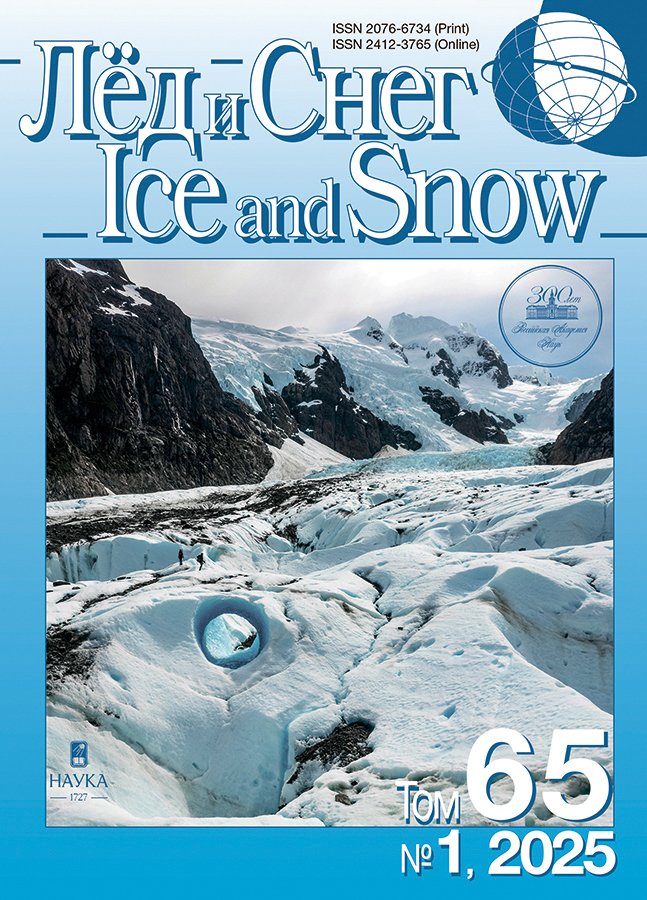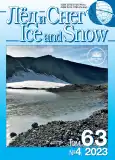Causes of Uncertainties in Paleoclimatic Reconstructions Based on the Oxygen Isotope Composition of Glacier Ice on Elbrus (Western Plateau)
- Authors: Chizhova J.N.1,2, Mikhalenko V.N.2, Kutuzov S.S.2,3, Lavrentiev I.I.2, Lipenkov V.Y.2,4, Kozachek A.V.4
-
Affiliations:
- Institute of Geology of Ore Deposits, Petrography, Mineralogy and Geochemistry, Russian Academy of Science
- Institute of Geography, Russian Academy of Science
- National Research University Higher School of Economics
- Arctic and Antarctic Research Institute
- Issue: Vol 63, No 4 (2023)
- Pages: 473-488
- Section: Glaciers and ice sheets
- URL: https://journals.rcsi.science/2076-6734/article/view/162299
- DOI: https://doi.org/10.31857/S2076673423040051
- EDN: https://elibrary.ru/HCCXEG
- ID: 162299
Cite item
Full Text
Abstract
Received July 28, 2023; revised September 2, 2023; accepted October 2, 2023
A study of the isotope signature of glacial ice in the Western Elbrus Plateau (the Caucasus) was made on the basis of five ice cores obtained in different years with high resolution. It was shown that the isotopic characteristics of ice are associated with the processes of accumulation and wind scouring of snow. Three ice cores were obtained in 2013 (C–1, C–2 and C–3), one in 2017 (C–4) and one more in 2018 (C–5). Core sampling was performed with a resolution of 5 cm. Isotopic analysis was done at the CERL laboratory (AARI) using a Picarro L2130-i isotope analyzer, the accuracy was 0.06‰ for δ18О and 0.30‰ for δ2Н. The values of δ18О and δ2Н of the ice of the Western Plateau generally vary from –5 to –30‰ and from –18.7 to –225.8‰, respectively, with well-defined seasonality. Comparison of the isotope record for all cores showed that the differences in accumulation for individual seasons reach 0.3 m w. eq., differences in accumulation for individual seasons averaged over 5 years is approximately 0.2 m w.eq. The absolute differences in the average seasonal values of δ18O associated with wind scouring and spatial redistribution of snow (deposition noise), averaged over 5 years, reached 1.38‰. The irregularity of precipitation amount within the season and errors in core dating are an additional contribution to non-climate variance (noise of definition). The absolute difference in the average seasonal values of δ18О associated with this type of noise averaged over 5 years is 1.7‰. Thus, the total uncertainty for two different types of noise can be estimated at 2.2‰, which is about 20% of the annual seasonal amplitude of δ18O values of the glacier ice in the Western Plateau (the average difference between the δ18O values of warm and cold seasons is ~10–11‰). One of the problems of linking the isotope record to the annual temperature record at the weather station was solved by using ammonium concentrations for dating the C-1 ice core and calculating the “ideal” annual variation of δ18O values by a cosine function of the annual amplitude. Using ammonium ion (\({\text{NH}}_{4}^{ + }\)) concentration each annual layer in C-1 ice core was divided into two parts associated to snow deposition in winter and in summer. It also showed δ18O values associated to change of seasons. The calculation of the cosine function showed the simplified δ18O values for each month of a particular year, due to which the δ18O values of the season boundaries in the ice core were linked to calendar months. This assimilation allowed us to compare the obtained average seasonal values of δ18О from the core with instrumental observations at the Klukhorskiy Pass meteorological station. The δ18O values of winter seasons have a weak relationship with surface temperatures, not only due to wind erosion, but also due to the high interannual variability of snow accumulation. At the same time, the average δ18O values of the warm seasons are significantly positive correlated with surface temperature (r = 0.7, p = 0.1), so ice core δ18O records can be used as a temperature proxy of the warm period.
About the authors
Ju. N. Chizhova
Institute of Geology of Ore Deposits, Petrography, Mineralogy and Geochemistry, Russian Academy of Science; Institute of Geography, Russian Academy of Science
Author for correspondence.
Email: eacentr@yandex.ru
Russia, Moscow; Russia, Moscow
V. N. Mikhalenko
Institute of Geography, Russian Academy of Science
Email: eacentr@yandex.ru
Russia, Moscow
S. S. Kutuzov
Institute of Geography, Russian Academy of Science; National Research University Higher School of Economics
Email: eacentr@yandex.ru
Russia, Moscow; Russia, Moscow
I. I. Lavrentiev
Institute of Geography, Russian Academy of Science
Email: eacentr@yandex.ru
Russia, Moscow
V. Ya. Lipenkov
Institute of Geography, Russian Academy of Science; Arctic and Antarctic Research Institute
Email: eacentr@yandex.ru
Russia, Moscow; Russia, Saint Petersburg
A. V. Kozachek
Arctic and Antarctic Research Institute
Email: eacentr@yandex.ru
Russia, Saint Petersburg
References
- Ekaykin A.A., Kozachek A.V., Mikhalenko V.N. Sposob vosstanovleniya ryadov meteorologicheskih harakteristik po dannym issledovaniya ledyanyh kernov gornyh rajonov. Method of restoring series of meteorological characteristics from research data of mountain area ice cores. Patent 2643706. Registration date: 05.02.2018.
- Kozachek A.B., Ekaikin A.A., Mikhalenko V.N., Lipenkov V.Ya., Kutuzov S.S. Isotopic composition of ice cores obtained on the Western Plateau of Elbrus. Led i Sneg. Ice and Snow. 2015, 55 (4): 35–49 [In Russian].
- Ledniki i klimat Elbrusa. Glaciers and climate of Elbrus. Moscow, St. Petersburg: Nestor-Istoriya, 2020: 372 p. [In Russian].
- Lavrentiev I.I., Mikhalenko V.N., Kutuzov S.S. Ice thickness and bedrock relief of the western Elbrus plateau. Led i Sneg. Ice and Snow. 2010, 2 (110): 12–18 [In Russian].
- Lavrentiev I.I., Kutuzov S.S., Mikhalenko V.N., Sudakova M.S., Kozachek A.V. Spatio-temporal variability of snow accumulation on the Western plateau of Elbrus (Central Caucasus). Led i Sneg. Ice and Snow. 2022, 62 (2): 165–178 [In Russian].
- Mikhalenko V.N., Kutuzov S.S., Lavrentiev I.I., Toropov P.A., Vladimirova D.O., Abramov A.A., Matskovsky V.V. Glacioclimatic studies of the Institute of Geography of the Russian Academy of Sciences in the crater of the Eastern peak of Elbrus in 2020. Led i Sneg. Ice and Snow. 2021, 61 (1): 149–160 [In Russian].
- Mikhalenko V.N. Ice drilling near the top of Elbrus. Led i Sneg. Ice and Snow. 2010, 1 (109): 123–126 [In Russian].
- Rototaeva O.V., Nosenko G.A., Kerimov A.M., Kutuzov S.S., Lavrentiev I.I., Nikitin S.A., Kerimov A.A., Tarasova L.N. Changes in the mass balance of the Garabashi (Elbrus) glacier at the turn of the 20th–21st centuries. Led i Sneg. Ice and Snow. 2019, 59 (1): 5–22 [In Russian].
- Bohleber P., Wagenbach D., Schöner W., Böhm R. To what extent do water isotope records from low accumulation Alpine ice cores reproduce instrumental temperature series? Tellus B: Chemical and Physical Meteorology. 2013, 65 (1): 20148. https://doi.org/10.3402/tellusb.v65i0.20148
- Craig H. Isotopic variations in meteoric waters. Science. 1961, 133 (3465): 1702–1703.
- Cuffey K.M., Steig E.J. Isotopic diffusion in polar firn: implications for interpretation of seasonal climate parameters in ice-core records, with emphasis on central Greenland. Journ. of Glaciology. 1998, 44: 273–284.
- Dansgaard W. Stable isotopes in precipitation. Tellus. 1964, 16: 436–468.
- Dansgaard W., Johnsen S.J., Clausen H.B., Dahl-Jensen D., Gundestrup N.S., Hammer C.U., Hvidberg C.S., Steffensen J.P., Sveinbjörnsdottir A.E., Jouzel J., Bond G. Evidence for general instability of past climate from a 250-kyr ice-core record. Nature. 1993, 364: 218–220. https://doi.org/10.1038/364218a0
- Fisher D.A., Koerner R.M., Paterson W.S.B., Dansgaard W., Gundestrup N., Reeh N. Effect of wind scouring on climatic records from ice-core oxygen-isotope profiles. Nature. 1983, 301: 205–209. https://doi.org/10.1038/301205a
- Fisher D.A., Reeh N., Clausen H.B. Stratigraphic noise in time series derived from ice cores. Annals of Glaciology. 1985, 7: 76–83.
- Fisher D., Koerner R. The effects of wind on δ(18O) and accumulation give an inferred record of seasonal δ amplitude from the Agassiz Ice Cap, Ellesmere Island, Canada. Annals of Glaciology. 1988, 10: 34–37. https://doi.org/10.3189/S0260305500004122
- Johnsen S.J. Stable isotope homogenization of polar firn and ice. In Isotopes and Impurities in Snow and Ice. Proceedings of the Grenoble Symposium, IAHS Publ., Grenoble, France, 1977. No. 118: 210–219.
- Johnsen S.J., Clausen H.B., Cuffey K.M., Hoffmann G., Schwander J., Creyts T. Diffusion of stable isotopes in polar firn and ice: the isotope effect in firn diffusion. In Physics of ice core records, edited by Hondoh T. Hokkaido Univ. Press, Sapporo, Japan, 2000: 121–140.
- Jouzel J., Alley R.B., Cuffey K., Dansgaard W., Grootes P., Hoffmann G., Johnsen S.J., Koster R., Peel D., Shuman C., Stievenard M., Stuiver M., White J. Validity of the temperature reconstruction from water isotopes in ice cores. Journ. of Geophysical Research. Oceans. 1997, 102: 26471–26487.
- Markle B., Steig E. Improving temperature reconstructions from ice-core water-isotope records. Climate of the Past. 2022, 18: 1321–1368.
- Merlivat L., Jouzel J. Global climatic interpretation of the deuterium-oxygen 18 relationship for precipitation. Journ. of Geophysical Research. Oceans. 1979, 84: 5029–5033.
- Mikhalenko V., Sokratov S., Kutuzov S., Ginot P., Legrand M., Preunkert S., Lavrentiev I., Kozachek A., Ekaykin A., Fain X., Lim S., Schotterer U., Lipenkov V., Toropov P. Investigation of a deep ice core from the Elbrus western plateau, the Caucasus, Russia. The Cryosphere. 2015, 9: 2253–2270. https://doi.org/org/10.5194/tc-9-2253-2015
- Münch T., Kipfstuhl S., Freitag J., Meyer H., Laepple T. Regional climate signal vs. local noise: a two-dimensional view of water isotopes in Antarctic firn at Kohnen station, Dronning Maud Land. Climate of the Past Discussions. 2015, 11: 5605–5649.
- Neumann T.A., Waddington E.D. Effects of firn ventilation on isotopic exchange. Journ. of Glaciology. 2004, 50: 183–194.
- Sime L.C., Marshall G.J., Mulvaney R., Thomas E.R. Interpreting temperature information from ice cores along the Antarctic Peninsula: ERA40 analysis. Geophys. Research Letters. 2009, 36: L18801. https://doi.org/10.1029/2009GL038982
- Sime L.C., Lang N., Thomas E.R., Benton A.K., Mulvaney R. On high-resolution sampling of short ice cores: dating and temperature information recovery from Antarctic Peninsula virtual cores. Journ. of Geophys. Research. 2011, 116: D20117. https://doi.org/10.1029/2011JD015894
- Toropov P.A., Aleshina M.A., Grachev A.M. Large-scale climatic factors driving glacier recession in the Greater Caucasus, 20th–21st century. International Journ. of Climatology. 2019, 39 (12): 4703–4720.
- Persson A., Langen P.L., Ditlevsen P., Vinther B.M. The influence of precipitation weighting on interannual variability of stable water isotopes in Greenland. Journ. of Geophys. Research. 2011, 116: D20120. https://doi.org/10.1029/2010JD015517
- Petit J.R., Jouzel J., Raynaud D., Barkov N.I., Barnola J.M., Basile I., Bender M., Chappellaz J., Davis M., Delaygue G., Delmotte M., Kotlyakov V.M., Legrand M., Lipenkov V.Y., Lorius C., Pépin L., Ritz C., Saltzman E., Stievenard M. Climate and atmospheric history of the past 420,000 years from the Vostok ice core, Antarctica. Nature. 1999, 399: 429–436.
- Preunkert S., Legrand M., Kutuzov S., Ginot P., Mikhalenko V., Friedrich R. The Elbrus (Caucasus, Russia) ice core record – Part 1: reconstruction of past anthropogenic sulfur emissions in south-eastern Europe. Atmospheric Chemistry and Physics. 2019, 19: 14119–14132. https://doi.org/10.5194/acp-19-14119-2019
- Steen-Larsen H.C., Masson-Delmotte V., Hirabayashi M., Winkler R., Satow K., Prié F., Bayou N., Brun E., Cuffey K.M., Dahl-Jensen D., Dumont M., Guillevic M., Kipfstuhl S., Landais A., Popp T., Risi C., Steffen K., Stenni B., Sveinbjörnsdottír A.E. What controls the isotopic composition of Greenland surface snow? Climate of the Past. 2014, 10: 377–392. https://doi.org/10.5194/cp-10-377-2014
- Town M.S., Warren S.G., von Walden P., Waddington E.D. Effect of atmospheric water vapor on modification of stable isotopes in near-surface snow on ice sheets. Journ. of Geophys. Research. 2008, 113: D24303. https://doi.org/10.1029/2008JD009852
- Waddington E.D., Steig E.J., Neumann T.A. Using characteristic times to assess whether stable isotopes in polar snow can be reversibly deposited. Annals of Glaciology. 2002, 35: 118–124.
- Whillans I.M., Grootes P.M. Isotopic diffusion in cold snow and firn. Journ. of Geophys. Research. 1985, 90: 3910–3918. https://doi.org/10.1029/JD090iD02p03910
- Yu W., Yao T., Thompson L.G., Jouzel J., Zhao H., Xu B., Jing Z., Wang N., Wu G., Ma Y., Gao J., Yang X., Zhang J., Qu D. Temperature signals of ice core and speleothem isotopic records from Asian monsoon region as indicated by precipitation δ18O. Earth and Planetary Science Letters. 2021, 554: 116665. https://doi.org/10.1016/j.epsl.2020.116665
Supplementary files















